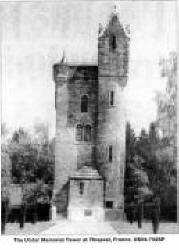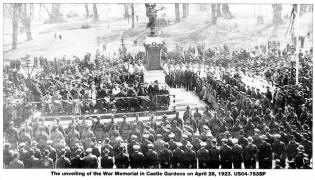
CITY'S CITIZENS 'SHOULD BE PROUD OF HERITAGE'
Why Lisburn's Somme heroes deserve to be remembered

LISBURN has a tremendous heritage of which her citizens should be proud.
Over the years the city has produced so many men and women willing to serve � and if necessary to die - in war, in order to win for us the freedom we enjoy today.
As just one example of that willingness to serve, a national newspaper article, which appeared not long after the start of the First World War, was headed `Magheragall Woman's Eight Sons Join'.
The article read: "Many instances of the patriotism of families have come to light in the North of Ireland, but few, if any, can excel that of Mrs. Hawthorn, of Magheragall, Lisburn, who has given no fewer than eight sons to the Army, seven of whom are in the Ulster Division.
"Five of her boys are serving with the 11th Battalion Royal Irish Rifles (South Antrim Volunteers).
"One is in the 10th Battalion Royal Irish Rifles (South Belfast Volunteers) at Ballykinlar. One is in the Royal Engineers of the Ulster Division, and one is in the Cameronians (Scottish Rifles).
"Mrs. Hawthorn is a widow, her husband having died a few weeks ago. The record of her family is a splendid one, and we congratulate her on having given eight stalwart sons to the service of the King."
While the story of Mrs. Hawthorn may be exceptional in her having given eight sons to serve in the Army, so many families in the Lisburn area knew what it was like to have husbands and sons joining up to serve their country.
And yet, the reality is that many young people today would have difficulty in telling you what happened at the Somme.
The Battle of the Somme began on July 1, 1916 in the area of the Valley of the Somme in Northern France.

It was a massive attack by the British, but one of the Divisions at the heart of that battle was the 36th Ulster Division, in which most of Mrs. Hawthorn's sons served.
When the Ulster Division came out of heir trenches early on that July 1 morning to attack the German trenches, they expected that they would march forward and occupy the German positions with few losses.
They had been told that the massive week-long British bombardment of the German positions would mean that there would be little opposition to the attack.
But as soon as the attack started, the Germans came out of the tunnels in which they had safely hidden from the British barrage - and opened up with machine guns and everything they had. It was a slaughter.
The 36th Ulster Division had 5,500 casualties, killed, wounded and missing, in the first two days of the battle. Horrendous numbers.
And yet, despite the slaughter, the men of the 36th Ulster Division kept going forward, and, despite their losses, were the only Division in the British Army to capture all of the German trenches they were ordered to capture that day.
Unfortunately, because they were so successful in pressing forward to capture German trenches, and the other Divisions around them couldn't keep up with the attack of the Ulster-men, the Ulster Division became isolated.
Once they were isolated they were open to German fire from both flanks, as well as from the front. The slaughter got worse. Thus their very success was actually one of the reasons for such losses of Ulster-men. And eventually they had to with-draw from the ground they had won at such an awful cost.
Mind you, some would say that at that time the 'higher up' British leadership, which ordered the attack, didn't have much respect for the lives of their ordinary soldiers, and ordered them to attack regard-less of the losses. Some said that the ordinary British soldiers at the Somme were just 'cannon fodder'.
This led to an historian saying that the men of the 36th Ulster Division were 'lions led by donkeys'.
But one British General who watched the heroism of the Ulster-men as they attacked that day said: "There is nothing I would rather be today than an Ulster-man." What a tribute to the courage of the men of Ulster.
And at the heart of that attack were the men from Lisburn. And we have to remember that others from Lisburn served at the Somme, as well as those of the 36th Ulster Division. But that's a story for another day.
There is another tribute to the men of Lisburn, and you might like to go and sec this one for yourself. By doing so you could pay your own tribute to those men.
One of the most famous paintings of the First World War is entitled 'Over the Top'. It was painted by J. P. Beadle and it depicts the South Antrim Volunteers, (the 11th Battalion of the Royal Irish Rifles) formed in the greater Lisburn area.
The painting shows the South Antrim Volunteers going 'Over the Top' at the start of the Battle of the Somme on July 1 1916.
If you do an organised tour of Belfast City Hall you can see the large original of the painting.
How do we know that the painting features the South Antrim Volunteers? Simply because in the painting you can sec the orange shoulder flashes, distinctive of the South Antrim Volunteers. Lisburn - hold your head up high.
I do not see any glory in war. And I do not glorify war. But I do believe it would he an awful shame if we fail to honour those who gave so much - those who served as well as those who died. And their families as well. That is why I write these occasional articles. These men (and in later conflicts these women), deserve to be remembered not just on Remembrance Sunday, but throughout the whole year. The other way I try to pay my own tribute to those who have served us in war, and try to enable others to pay a tribute to them, is by organising and leading each year Battlefield Tours.
This year Maureen and I are organising three coach-tours going off to the sites where history was made.
The first of these pilgrimages, in May this year, will be to the area of the Battle of the Somme.
As well as walking amongst the headstones, amongst other things we will be visiting the Ulster Tower (the Memorial to all the men of Ulster), the Thiepval Memorial (to those who died at the Somme and who have no known grave), and also Newfoundland Park.
At Newfoundland Park you can still see today some of the original trenches from 1916. This tour also takes in all of the beaches and airborne landing areas of D Day, the 6th June 1944, in Normandy.
We take in Pegasus Bridge, Merville Gun Battery, Ranville Commonwealth War Graves Cemetery, the American Military Cemetery at Omaha Beach, the German Military Cemetery, the Royal Ulster Rifles Memorial, and much, much more.
As well as that there is still time for visiting the beautiful sea-port of Honfleur where the rich Parisians love to holiday. And shopping at Cite Europe, a massive French Hyper-Marche. A further tour - in September - goes to the Evacuation Beaches of Dunkirk, the Battlefield of Passchendaele (Ypres), and the 'Bridge Too Far' at Arnhem.
The third tour goes through France, Belgium, Luxembourg, Germany, and Czechoslovakia, to Poland to visit the Auschwitz Extermination Camp, also visiting Colditz Castle and other places of interest concerning the Second World War.
If anyone would like more information on any of these tours I can be contacted on 9269 0701.
The unveiling of the War Memorial in Castle Gardens on April 28. 1923. USO4-753SP


